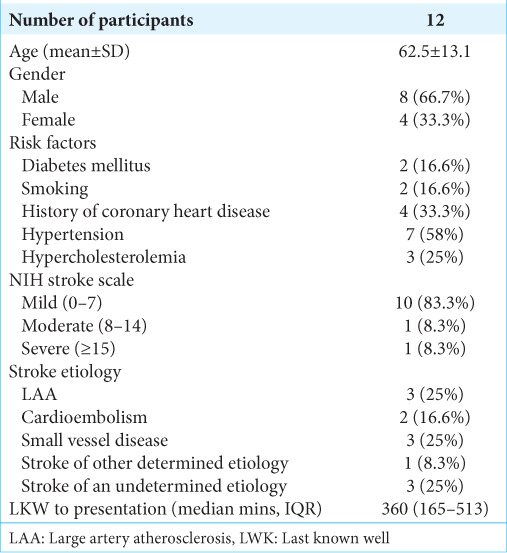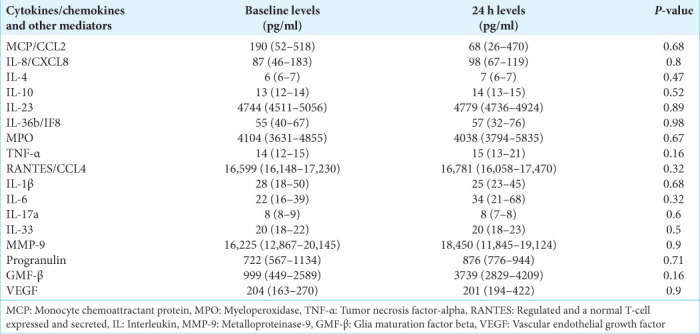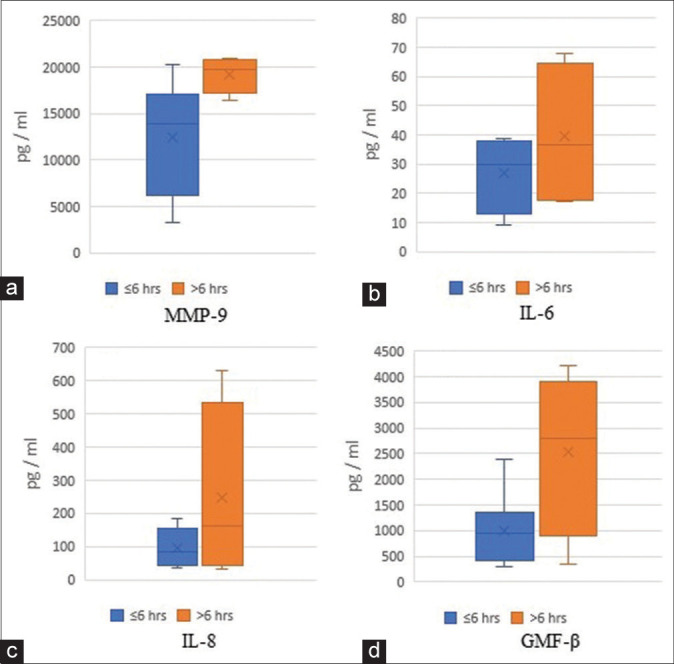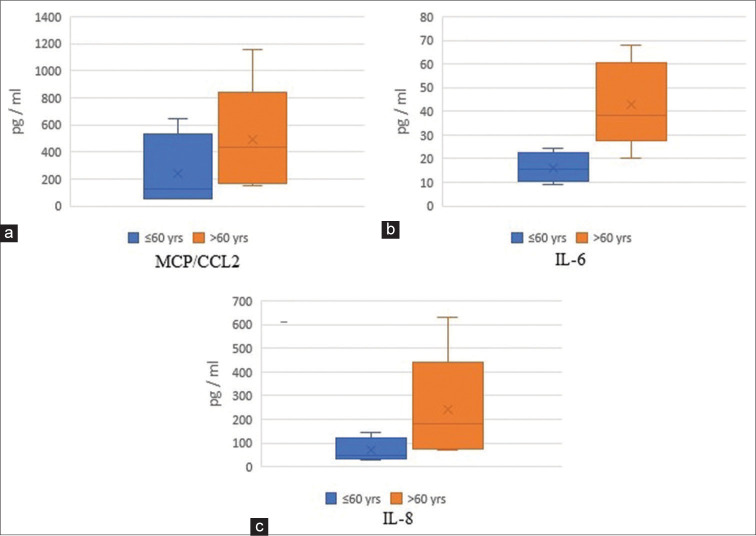Abstract
Background:
Immunomodulation and cell signaling involve several cytokines, proteins, and other mediators released in response to the trauma, inflammation, or other insults to the central nervous system. This pilot study is part of the registry designed to evaluate the temporal trends among these molecules after an acute ischemic stroke (AIS) in patients.
Methods:
Twelve AIS patients were enrolled within 24 hours of the symptoms onset. Two sets of plasma samples were collected: First at admission and second at 24 hours after admission. Cytokines/chemokines and other inflammatory molecules were measured using multiplex assay kit.
Results:
An increased trend in IL-6 (22 vs. 34 pg/ml), IL-8/CXCL8 (87 vs. 98 pg/ml), MMP-9 (16225 vs. 18450 pg/ml), and GMF-β (999 vs. 3739 pg/ml) levels was observed overtime after an AIS. Patients ≤60 years had lower levels of plasma MCP-1/CCL2 (50–647 vs. 150–1159 pg/ml), IL-6 (9–25 vs. 20–68 pg/ml), and IL-8 (30– 143 vs. 72–630 pg/ml), when compared with patients >60 years old.
Conclusion:
Cytokines/chemokines and other inflammatory mediators play an important role in the pathogenesis of stroke in addition to mediating poststroke inflammation. Further research is needed to evaluate and characterize the cumulative trends of these mediators for the clinical prognosis or as surrogate biomarkers.
Keywords: Acute ischemic brain injury, Cytokine, Interleukin, Poststroke inflammation, Stroke

INTRODUCTION
In the United States (US), stroke is the fifth leading cause of mortality, affecting approximately 0.8 million people every year.[4] Ischemic stroke (IS) constitutes two-third of all strokes.[4] Ischemia to the brain precipitates cellular hypoxemia initiating oxidative damage, resulting in dysfunctional neurovascular unit and impair blood brain barrier (BBB). This inflammatory response is mediated by injured cells which produce interleukins (ILs)/cytokines/chemokines, interferons (INFs), and other growth stimulating factors, acting as both neuro- and immune-mediators.[27] Previous studies have observed the association of these molecules (both pro- and anti-inflammatory) with functional outcomes, infarct volume, stroke severity, and prognostication among IS patients.[15,24,26,27,29] However, there still exists a lack of consensus in the available data for a complete understanding of this intricate inflammatory response. Although, studies have observed these cytokines and cellular proteins dispersedly, the critical understanding is to elucidate the expression of these molecules focusing on the integrated synchronous trends and their association during the early phase. Glia maturation factor (GMF) is an intracellular, pro-inflammatory brain protein that has been implicated in neurodegenerative diseases. This is the first clinical study observing the role of GMF in acute stroke. This pilot study is part of the registry (https://clinicaltrials.gov/ct2/show/NCT03297827) to assess the collective temporal trends among these cytokines/chemokines and other mediators after acute ischemic stroke (AIS).[9]
MATERIALS AND METHODS
Twelve consecutive adult (>18 years) AIS patients presenting within 24 hours of the onset of symptoms were consented for this institutional (University of Iowa, Iowa City, IA) review board (IRB) approved study in accordance with the ethical standards of the Declaration of Helsinki. Blood samples were collected at the time of admission and after 24 hours. Exclusion criteria were; prior stroke or any other neurodegenerative or neuroinflammatory disease (Alzheimer’s disease, Parkinson’s disease [PD], multiple sclerosis [MS], etc.), acute infection, chronic inflammatory systemic illness, pregnancy, use of immunosuppressive medications or steroids, and a premorbid modified Rankin score ≥5. Diagnosis of IS was based on clinical and radiological evidence at the discretion of the stroke neurologist. Patients clinical characteristics including stroke etiology and stroke severity were collected.[1,17] Detailed methodology, specimen collection, preparation, measurement, and additional laboratory processing are described previously.[9] Serum was separated from blood by centrifugation, aliquoted, and stored at −80°C. Monocyte chemoattractant protein (MCP)/CCL2, ILs-8/ CXCL8, IL-4, IL-10, IL-23, IL-36b/IF8, myeloperoxidase, tumor necrosis factor-alpha (TNF-α), regulated and a normal T-cell expressed and secreted/CCL4, IL-1β, IL-6, IL-17A, IL-33, matrix metalloproteinase-9 (MMP-9), progranulin, and vascular endothelial growth factor were measured using human premixed multianalyte kit (R&D System, Minneapolis, MN); GMF-β was measured by enzyme-linked immunosorbent assay (ELISA), Proteintech (Chicago, IL). All assays were performed as manufacturer’s kit instructions, and the ELISA plate was read using a microplate reader (VERSAmax Microplate Reader, Molecular Devices, Sunnyvale, CA) and the multiplex assay plate was read using a BioRad BioPlex multiplexing system (Flow Cytometry Core Facility, University of Iowa Carver College of Medicine, Iowa City, IA). Data will be made available on reasonable request from the corresponding author.
RESULTS
Patient’s demographics, stroke etiology, and severity are described. [Table 1] Majority (66.7%) were male, and the mean age of the cohort was 62.5 years. We observed an increasing trend in IL-6 (22 vs. 34 pg/ml), IL-8/CXCL8 (87 vs. 98 pg/ml), MMP-9 (16225 vs. 18450 pg/ml), and GMF-β (999 vs. 3739 pg/ ml) from baseline when compared with 24 hours, while other cytokines/chemokines and neural molecules remained stable overtime. The difference was insignificant [Table 2]. Moreover, patients presenting within 6 hours from their last known well had lower levels of MMP-9 (3287–20,215 vs. 16,435–20,936 pg/ ml), IL-6 (9–39 vs. 17–68 pg/ml), IL-8/CXCL8 (34–143 vs. 31–630 pg/ml), and GMF-β (300–2379 vs. 339–4209 pg/ml) as compare to patients presenting later [Figure 1]. We also observed that at admission, patients ≤60 years exhibit lower levels of plasma MCP-1/CCL2 (50–647 vs. 150–1159 pg/ml), IL-6 (9–25 vs. 20–68 pg/ml), and IL-8 (30–143 vs. 72–630 pg/ml) levels, when compared with patients >60 years old [Figure 2].
Table 1:
Demographics and clinical characteristics of the study participants.

Table 2:
Levels of cytokines/chemokines and other molecules at admission and after 24 hours among ischemic stroke patients admitted within 24 hours from last known well.

Figure 1:

(a) Serum MMP-9 (b) IL-6, (c) IL-8, and (d) GMF-β levels among patients presenting <6 h versus later after symptoms onset. MMP-9: Metalloproteinase-9, IL: Interleukin, GMF-β: Glia maturation factor beta.
Figure 2:
(a) MCP/CCL2, (b) IL-6, and (c) IL-8 levels among patients with age ≤60 years versus >60 years at baseline. MCP: Monocyte chemoattractant protein, IL: Interleukin.
DISCUSSION
Our pilot study observed an increasing trend overtime in IL-6, IL-8, MMP-9, and GMF-β levels after an AIS. We also observed that MCP/CCL2, IL-6, and IL-8 levels were increased among older AIS patients (>60 years).
This is the first report characterizing GMF-β levels in AIS patients. GMF-β is a pro-inflammatory protein expressed in the brain, especially in neurons, microglia, and astrocytes.[16,28] Our study observed increasing levels of GMF-β after AIS. GMF-β is implicated in the activation and proliferation of microglial cells, consequently upregulating pro-inflammatory cytokines including TNF-a, IL-1 β, and IL-6. We have recently shown that the absence of GMF-β reduces inflammation and improves behavioral impairments in traumatic brain injury mice models.[2,25] In addition, we have also shown that GMF increases glial cell activation neuronal damage and that the absence of GMF decreased oxidative stress-associated neuroinflammation in the cell culture model of TBI.[3] Evidence indicate the role of GMF-β as a pro-inflammatory trigger in the pathogenesis and progression of neurodegenerative and neuroinflammatory diseases including central nervous system injury, Alzheimer’s, PD, and MS.[8,13,30] However, the exact mechanism involving the role of GMF-β in AIS remains to be characterized.
We also observed increased levels of acute-phase pro-inflammatory cytokines, IL-6, IL-8, and MCP-1/CCL2. IL-6 is an endogenous pyrogen induced by IL-2, IL-4, prostaglandins, and interferon-gamma, while IL-8 is induced by macrophages and MCP-1/CCL2 by microglia/macrophages, endothelial cells, astrocytes, and neurons; acting as a chemoattractant for neutrophils, helping recruit inflammatory cells to the site of injury during the early phase inflammatory response. Studies have reported increased IL-6 and IL-8 levels as early as 1–4 hours after ischemic insult and remain elevated for the next 24–72 hours.[10,14] The REGARDS case–cohort study estimated an increased risk of IS incident with an incremental IL-6 levels being highest (HR: 2.4) among patients within the fourth quartile of IL-6 levels.[12] The study also reported increased IL-8 levels; however, it was not associated with an increased risk of stroke incidence. This contrasted with the studies from Kostulas et al. and Ormstad et al., where they reported significant association of increased IL-8 levels among AIS patients.[14,21] Our study also corroborates these findings characterizing increase IL-6 levels during the earliest phase of the ischemic injury, thus, supporting the notion that IL-6 may be an early inflammatory predictive marker of acute ischemic brain injury.[21] Moreover, results demonstrated that IL-6, IL-8, and MCP-1/CCL2 are also increased among older AIS patients. Similar observations were noted in REGARDS study where they observed increasing IL-6 levels with an incremental increased age (3.6 vs. 4.1 vs. 4.7 ng/ml; P < 0.001 for <64, 64–75, and >75 years, respectively) and the Health ABC study, where the authors reported an increased risk of IS (RR: 3.7) among older patients within the highest IL-6 tertile levels.[7] Likewise, Ormstad et al. observed a significant association of IL-8 levels with an increasing age (r = 0.52, P < 0.001). Similar observations have been noted for MCP-1/CCL2, establishing the association of increased levels with stroke severity and functional outcome after an AIS.[5] Population studies have also observed that an increased circulating level of MCP-1/CCL2 is an independent predictor of IS.[11] However, age-related characterization of MCP-1/ CCL2 among AIS patients still remains to be elucidated. We also observed an increasing trend in MMP-9 as demonstrated by the previous studies,[18,23] peaking during the early phase within 12–24 hours.[19] MMP-9 are zinc metalloproteins involved in the breakdown of the extracellular matrix. The previous studies have shown that MMP-9 is involved in the inflammatory response and BBB breakdown after an ischemic insult.[22] Increased MMP-9 levels after AIS are also associated with poor functional outcome and hemorrhage after thrombolytic therapy among AIS patients.[6,20]
These observations corroborate the role of these pro- and anti-inflammatory cytokines and other mediators in AIS patients, however, prognostication and clinical utility of these cytokines in predicting functional outcome, stroke types, and mortality are still debatable. Cytokines/chemokines constitute part of a complex immune system. Disruption in the intricate pathway implies downstream modulation on the dynamic feedback circuitry. As we expand our understanding of these molecular interactions, there still remains a lack of knowledge concerning integrative molecular alterations and their impact. The proposed comprehensive database comprising clinical, imaging, and molecular data would help expand our understanding and elucidate molecules that are systemically altered in AIS patients. “Cytokine Registry In Stroke Patients,” NCT03297827 was established to study the role of these cytokines and molecules and their trend variations in stroke patients, eventually leading to develop new therapeutic and management strategies.
CONCLUSION
This preliminary study reports the trends in GMF-β, a pro-inflammatory protein in AIS patients. We also corroborated findings of acute-phase inflammatory cytokines/chemokines and protein, including IL-6, IL-8, MCP-1/CCL2, and MMP-9 during the early phase after an acute ischemic injury.
Footnotes
How to cite this article: Zafar A, Farooqui M, Ikram A, Suriya S, Kempuraj D, Khan M, et al. Cytokines, brain proteins, and growth factors in acute stroke patients: A pilot study. Surg Neurol Int 2021;12:366.
Contributor Information
Atif Zafar, Email: Atif.zafar@unityhealth.to.
Mudassir Farooqui, Email: mudassir-farooqui@uiowa.edu.
Asad Ikram, Email: aikram@salud.unm.edu.
Sajid Suriya, Email: ssuriya@salud.unm.edu.
Duraisamy Kempuraj, Email: duraisamyk@health.missouri.edu.
Mohammad Khan, Email: mkhan26@uthsc.edu.
Nudrat Tasneem, Email: nudrat-tasneem@uiowa.edu.
Dania Qaryouti, Email: daniaqaryoute@gmail.com.
Syed Quadri, Email: saquadri@mgh.harvard.edu.
Harold P. Adams, Email: harold-adams@uiowa.edu.
Santiago Ortega-Gutierrez, Email: santy-ortega@uiowa.edu.
Enrique Leira, Email: enrique-leira@uiowa.edu.
Asgar Zaheer, Email: zaheera@health.missouri.edu.
Clinical trial registration
URL: http://www.clinicaltrials.gov Unique identifier: NCT03297827.
Cytokine Registry In Stroke Patients (CRISP) trial.
Declaration of patient consent
Institutional Review Board (IRB) permission obtained for the study.
Financial support and sponsorship
Stoppelmoor – Adams Stroke Education and Research Fund.
Conflicts of interest
There are no conflicts of interest.
REFERENCES
- 1.Adams HP, Jr, Bendixen BH, Kappelle LJ, Biller J, Love BB, Gordon DL, et al. Classification of subtype of acute ischemic stroke, Definitions for use in a multicenter clinical trial, TOAST. Trial of org 10172 in acute stroke treatment. Stroke. 1993;24:35–41. doi: 10.1161/01.str.24.1.35. [DOI] [PubMed] [Google Scholar]
- 2.Ahmed ME, Selvakumar GP, Kempuraj D, Raikwar SP, Thangavel R, Bazley K, et al. Glia maturation factor (GMF) regulates microglial expression phenotypes and the associated neurological deficits in a mouse model of traumatic brain injury. Mol Neurobiol. 2020;57:4438–50. doi: 10.1007/s12035-020-02040-y. [DOI] [PubMed] [Google Scholar]
- 3.Ahmed ME, Selvakumar GP, Kempuraj D, Raikwar SP, Thangavel R, Bazley K, et al. Neuroinflammation mediated by glia maturation factor exacerbates neuronal injury in an in vitro model of traumatic brain injury. J Neurotrauma. 2020;37:1645–55. doi: 10.1089/neu.2019.6932. [DOI] [PMC free article] [PubMed] [Google Scholar]
- 4.Benjamin EJ, Virani SS, Callaway CW, Chamberlain AM, Chang AR, Cheng S, et al. Heart disease and stroke statistics-2018 update: A report from the American heart association. Circulation. 2018;137:e67–492. doi: 10.1161/CIR.0000000000000558. [DOI] [PubMed] [Google Scholar]
- 5.Bonifačić D, Toplak A, Benjak I, Tokmadžić VS, Lekić A, Kučić N. Monocytes and monocyte chemoattractant protein 1 (MCP-1) as early predictors of disease outcome in patients with cerebral ischemic stroke. Wien Klin Wochenschr. 2016;128:20–7. doi: 10.1007/s00508-015-0878-4. [DOI] [PubMed] [Google Scholar]
- 6.Castellanos M, Sobrino T, Millán M, García M, Arenillas J, Nombela F, et al. Serum cellular fibronectin and matrix metalloproteinase-9 as screening biomarkers for the prediction of parenchymal hematoma after thrombolytic therapy in acute ischemic stroke: A multicenter confirmatory study. Stroke. 2007;38:1855–9. doi: 10.1161/STROKEAHA.106.481556. [DOI] [PubMed] [Google Scholar]
- 7.Cesari M, Penninx BW, Newman AB, Kritchevsky SB, Nicklas BJ, Sutton-Tyrrell K, et al. Inflammatory markers and onset of cardiovascular events: Results from the health ABC study. Circulation. 2003;108:2317–22. doi: 10.1161/01.CIR.0000097109.90783.FC. [DOI] [PubMed] [Google Scholar]
- 8.Fan J, Fong T, Chen X, Chen C, Luo P, Xie H. Glia maturation factor-β: A potential therapeutic target in neurodegeneration and neuroinflammation. Neuropsychiatr Dis Treat. 2018;14:495–504. doi: 10.2147/NDT.S157099. [DOI] [PMC free article] [PubMed] [Google Scholar]
- 9.Farooqui M, Ikram A, Suriya S, Saleem S, Quadri SA, Robinson M, et al. Cytokine registry in stroke patients (CRISP): Protocol of a prospective observational study. Medicine (Baltimore) 2020;99:e20921. doi: 10.1097/MD.0000000000020921. [DOI] [PMC free article] [PubMed] [Google Scholar]
- 10.Fassbender K, Rossol S, Kammer T, Daffertshofer M, Wirth S, Dollman M, et al. Proinflammatory cytokines in serum of patients with acute cerebral ischemia: Kinetics of secretion and relation to the extent of brain damage and outcome of disease. J Neurol Sci. 1994;122:135–9. doi: 10.1016/0022-510x(94)90289-5. [DOI] [PubMed] [Google Scholar]
- 11.Georgakis MK, Malik R, Björkbacka H, Pana TA, Demissie S, Ayers C, et al. Circulating monocyte chemoattractant protein-1 and risk of stroke: Meta-analysis of population-based studies involving 17 180 individuals. Circ Res. 2019;125:773–82. doi: 10.1161/CIRCRESAHA.119.315380. [DOI] [PMC free article] [PubMed] [Google Scholar]
- 12.Jenny NS, Callas PW, Judd SE, McClure LA, Kissela B, Zakai NA, et al. Inflammatory cytokines and ischemic stroke risk: The REGARDS cohort. Neurology. 2019;92:e2375–84. doi: 10.1212/WNL.0000000000007416. [DOI] [PMC free article] [PubMed] [Google Scholar]
- 13.Kempuraj D, Selvakumar GP, Thangavel R, Ahmed ME, Zaheer S, Kumar KK, et al. Glia maturation factor and mast cell-dependent expression of inflammatory mediators and proteinase activated receptor-2 in neuroinflammation. J Alzheimers Dis. 2018;66:1117–29. doi: 10.3233/JAD-180786. [DOI] [PMC free article] [PubMed] [Google Scholar]
- 14.Kostulas N, Pelidou SH, Kivisäkk P, Kostulas V, Link H. Increased IL-1β, IL-8, and IL-17 mRNA expression in blood mononuclear cells observed in a prospective ischemic stroke study. Stroke. 1999;30:2174–9. doi: 10.1161/01.str.30.10.2174. [DOI] [PubMed] [Google Scholar]
- 15.Lambertsen KL, Biber K, Finsen B. Inflammatory cytokines in experimental and human stroke. J Cereb Blood Flow Metab. 2012;32:1677–98. doi: 10.1038/jcbfm.2012.88. [DOI] [PMC free article] [PubMed] [Google Scholar]
- 16.Lim R, Liu YX, Zaheer A. Cell-surface expression of glia maturation factor beta in astrocytes. FASEB J. 1990;4:3360–3. doi: 10.1096/fasebj.4.15.2253851. [DOI] [PubMed] [Google Scholar]
- 17.Logallo N, Novotny V, Assmus J, Kvistad CE, Alteheld L, Rønning OM, et al. Tenecteplase versus alteplase for management of acute ischaemic stroke (NOR-TEST): A phase 3, randomised, open-label, blinded endpoint trial. Lancet Neurol. 2017;16:781–8. doi: 10.1016/S1474-4422(17)30253-3. [DOI] [PubMed] [Google Scholar]
- 18.Lynch JR, Blessing R, White WD, Grocott HP, Newman MF, Laskowitz DT. Novel diagnostic test for acute stroke. Stroke. 2004;35:57–63. doi: 10.1161/01.STR.0000105927.62344.4C. [DOI] [PubMed] [Google Scholar]
- 19.Montaner J, Alvarez-Sabín J, Molina C, Anglés A, Abilleira S, Arenillas J, et al. Matrix metalloproteinase expression after human cardioembolic stroke: Temporal profile and relation to neurological impairment. Stroke. 2001;32:1759–66. doi: 10.1161/01.str.32.8.1759. [DOI] [PubMed] [Google Scholar]
- 20.Ning M, Furie K, Koroshetz W, Lee H, Barron M, Lederer M, et al. Association between tPA therapy and raised early matrix metalloproteinase-9 in acute stroke. Neurology. 2006;66:1550–5. doi: 10.1212/01.wnl.0000216133.98416.b4. [DOI] [PubMed] [Google Scholar]
- 21.Ormstad H, Aass HC, Lund-Sørensen N, Amthor KF, Sandvik L. Serum levels of cytokines and C-reactive protein in acute ischemic stroke patients, and their relationship to stroke lateralization, type, and infarct volume. J Neurol. 2011;258:677–85. doi: 10.1007/s00415-011-6006-0. [DOI] [PMC free article] [PubMed] [Google Scholar]
- 22.Ramos-Fernandez M, Bellolio MF, Stead LG. Matrix metalloproteinase-9 as a marker for acute ischemic stroke: A systematic review. J Stroke Cerebrovasc Dis. 2011;20:47–54. doi: 10.1016/j.jstrokecerebrovasdis.2009.10.008. [DOI] [PubMed] [Google Scholar]
- 23.Reynolds MA, Kirchick HJ, Dahlen JR, Anderberg JM, McPherson PH, Nakamura KK, et al. United Kingdom: Oxford University Press; 2003. Early Biomarkers of Stroke. [DOI] [PubMed] [Google Scholar]
- 24.Rosell A, Cuadrado E, Ortega-Aznar A, HernándezGuillamon M, Lo EH, Montaner J. MMP-9-positive neutrophil infiltration is associated to blood-brain barrier breakdown and basal lamina Type IV collagen degradation during hemorrhagic transformation after human ischemic stroke. Stroke. 2008;39:1121–6. doi: 10.1161/STROKEAHA.107.500868. [DOI] [PubMed] [Google Scholar]
- 25.Selvakumar GP, Ahmed ME, Iyer SS, Thangavel R, Kempuraj D, Raikwar SP, et al. Absence of glia maturation factor protects from axonal injury and motor behavioral impairments after traumatic brain injury. Exp Neurobiol. 2020;29:230–48. doi: 10.5607/en20017. [DOI] [PMC free article] [PubMed] [Google Scholar]
- 26.Suriya S, Farooqui M, Ikram A, Qaryouti D, Quadri S, Gutierrez SO, et al. Role of Cytokines in Acute Ischemic Stroke Patients: Preliminary Analysis of a Prospective Database (5521), AAN Enterprises. 2020.
- 27.Vila N, Castillo J, Dávalos A, Chamorro A. Proinflammatory cytokines and early neurological worsening in ischemic stroke. Stroke. 2000;31:2325–9. doi: 10.1161/01.str.31.10.2325. [DOI] [PubMed] [Google Scholar]
- 28.Wang BR, Zaheer A, Lim R. Polyclonal antibody localizes glia maturation factor beta-like immunoreactivity in neurons and glia. Brain Res. 1992;591:1–7. doi: 10.1016/0006-8993(92)90971-b. [DOI] [PubMed] [Google Scholar]
- 29.Zafar A, Ikram A, Jillella DV, Kempuraj D, Khan MM, Bushnaq S, et al. Measurement of elevated IL-37 levels in acute ischemic brain injury: A cross-sectional pilot study. Cureus. 2017;9:e1767. doi: 10.7759/cureus.1767. [DOI] [PMC free article] [PubMed] [Google Scholar]
- 30.Zaheer A, Zaheer S, Sahu SK, Knight S, Khosravi H, Mathur SN, et al. A novel role of glia maturation factor: Induction of granulocyte-macrophage colony-stimulating factor and pro-inflammatory cytokines. J Neurochem. 2007;101:364–76. doi: 10.1111/j.1471-4159.2006.04385.x. [DOI] [PubMed] [Google Scholar]



